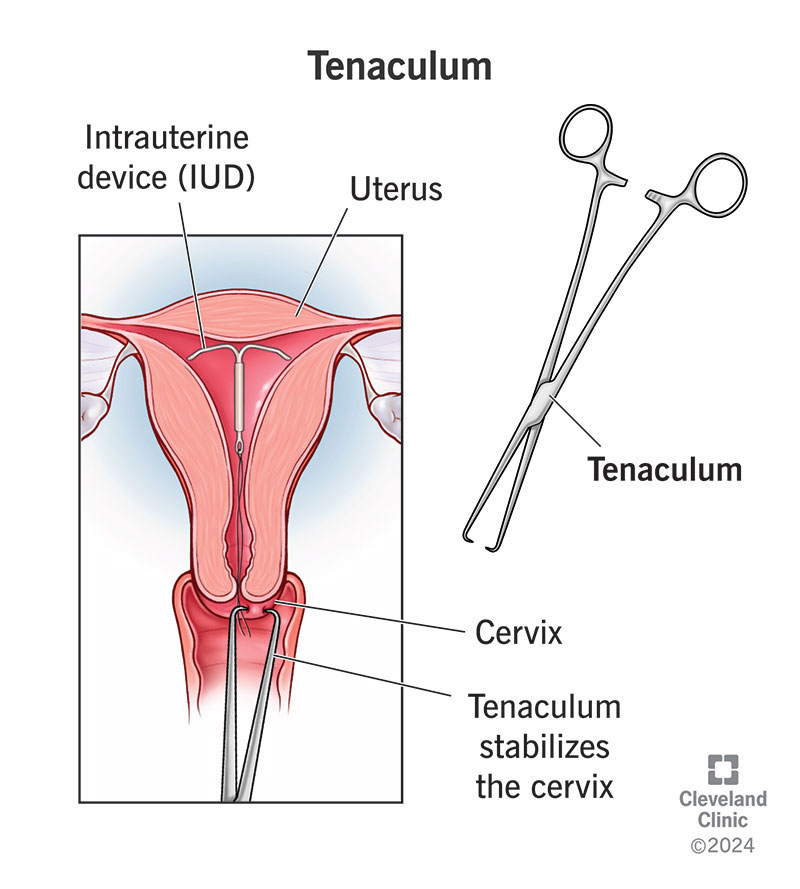A tenaculum is a type of forceps that healthcare providers use to grasp or grip tissue. It’s common for gynecologists to use one to hold your cervix while inserting an IUD or performing a biopsy. Due to its sharp ends, it can feel uncomfortable.
Advertisement
Cleveland Clinic is a non-profit academic medical center. Advertising on our site helps support our mission. We do not endorse non-Cleveland Clinic products or services. Policy

A tenaculum is a surgical tool healthcare providers use to grasp or clamp an object. It’s typically classified as a type of forceps. These instruments help healthcare providers perform tasks during medical procedures similarly to how tongs or tweezers help you with tasks at home.
Advertisement
Cleveland Clinic is a non-profit academic medical center. Advertising on our site helps support our mission. We do not endorse non-Cleveland Clinic products or services. Policy
A tenaculum has a scissor-like appearance. The top, or handle part, of the device has two holes to place your fingers through (like scissors). The bottom part is slender with a sharp, pointed or flat hook at the tip. This hook is what helps grasp and grip objects during surgery.
It’s usually made of stainless steel but can be made of other metals or medical-grade plastic. The design isn’t super complex and it’s easy to use.
There are several different types of tenaculum forceps. Each one has a slightly different, unique feature that makes it better suited for certain types of tissue. For example, one type may be better for very delicate tissue while one is better at grasping thick tissue.
Advertisement
Its main job is to hold tissues and other objects in a specific place during a surgical procedure. For example, it can help a surgeon hold back an area of tissue to better visualize the area they’re operating on. A tenaculum can also help clamp or tie off blood vessels or arteries to prevent excessive bleeding during surgery.
A tenaculum is most prevalent in gynecology and obstetrics (female reproductive health). It helps your provider stabilize (keep still) your cervix for various procedures like:
You may feel discomfort when your provider inserts a tenaculum, especially for a gynecological procedure you’re awake for like IUD insertion. The ends of a tenaculum are sharp and made to grasp objects securely. While it can be uncomfortable, the firm hold on your cervix is usually necessary to complete the procedure. Some people describe it as a strong pinch.
Discuss your options for minimizing discomfort with your healthcare provider. Some providers may offer a local anesthetic like lidocaine to help numb your cervix, but this is rare. Instead, you could take over-the-counter (OTC) pain relievers like ibuprofen before the procedure to help with pain.
Most healthcare providers prefer to use a device to steady your cervix during an IUD insertion. A tenaculum helps make the insertion process easier because it holds back the cervix to allow your provider to accurately place the IUD into your uterus. If you have concerns about this process, talk to your provider about alternatives or if it’s possible to insert an IUD without a tenaculum.
A tenaculum is safe, but it can come with risks. Some of the risks are that it can:
If you have concerns about your provider using a tenaculum, ask them if there are other tools they could use in its place.
Yes, it works by slightly puncturing the tissue of your cervix to better grip it. The hooks on the end of the tenaculum grasp objects or tissue to keep a steady hold on them.
A speculum is a device your healthcare provider uses to open and widen your vaginal walls. It helps them better examine your cervix, especially during a pelvic exam or Pap smear.
A tenaculum is a medical device that’s been around for centuries. It recently gained popularity because more people are using IUDs as a form of pregnancy prevention. It’s common for providers to use a tenaculum during this procedure to steady your cervix before inserting the IUD. If you’re unsure about what to expect for an IUD insertion or any other gynecological procedure, talk to your healthcare provider. They can let you know what to expect and what your options are.
Advertisement
Advertisement
Your Ob/Gyn is there for you throughout many different parts of your life. At Cleveland Clinic, our experts can help you throughout your entire journey.

Last reviewed on 05/15/2024.
Learn more about the Health Library and our editorial process.